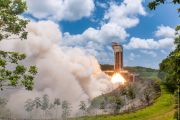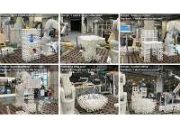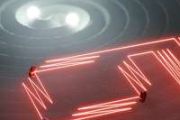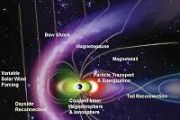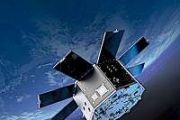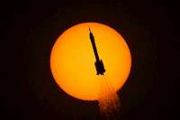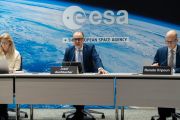
Copernical Team
Second Space Resources Challenge: from concept to reality at LUNA

Last year, ESA invited innovators across Europe to join the second Space Resources Challenge, a competition designed to accelerate technologies that will help humankind live and work sustainably on the Moon.
Last week, that challenge culminated in a field test lasting several days at the ESA-DLR LUNA facility in Cologne, Germany, where eight teams demonstrated robotic systems capable of collecting and processing lunar soil, known as regolith. The participating teams came from six countries—Canada, Denmark, Germany, Luxembourg, Poland and the United Kingdom—highlighting the global collaboration driving forward lunar exploration.
Vinci test motor for Ariane 6 to be assembled at DLR test centre

Week in images: 20-24 October 2025

Week in images: 20-24 October 2025
Discover our week through the lens
Earth from space: Likouala-aux-Herbes river, Congo
 Image:
This Copernicus Sentinel-2 image captures the meandering course of the Likouala-aux-Herbes river in the Republic of the Congo.
Image:
This Copernicus Sentinel-2 image captures the meandering course of the Likouala-aux-Herbes river in the Republic of the Congo. Eligibility for Bonuses In Non Gamstop £5 Deposit Casinos
 Self-exclusion is a popular responsible gambling tool to prevent yourself from gambling for a specific period of time. Online casinos licensed by the UK Gambling Commission are obliged to register with Gamstop and prevent players who have decided to take a break from gambling.
Self-exclusion is a popular responsible gambling tool to prevent yourself from gambling for a specific period of time. Online casinos licensed by the UK Gambling Commission are obliged to register with Gamstop and prevent players who have decided to take a break from gambling. Focusing on NGC 3370
 Image:
Focusing on NGC 3370
Image:
Focusing on NGC 3370 Mapping previously unseen galactic structures reveals new secrets of Milky Way star formation
 An international collaboration has successfully charted extensive regions of CO-dark molecular gas within Cygnus X, a vibrant star-forming segment of our Milky Way. Utilizing data from the National Science Foundation's Green Bank Telescope, the team produced unprecedented maps showcasing previously invisible material crucial to star birth. Cold molecular hydrogen gas, the essential component in
An international collaboration has successfully charted extensive regions of CO-dark molecular gas within Cygnus X, a vibrant star-forming segment of our Milky Way. Utilizing data from the National Science Foundation's Green Bank Telescope, the team produced unprecedented maps showcasing previously invisible material crucial to star birth. Cold molecular hydrogen gas, the essential component in Newly found rocky super-Earth could become key focus in search for life
 An international scientific team, including Penn State researchers, has identified a super-Earth exoplanet named GJ 251 c orbiting a nearby dwarf star less than 20 light-years away. The planet is estimated to have nearly four times the mass of Earth and is likely rocky.
Suvrath Mahadevan, professor of astronomy at Penn State, explained, "We look for these types of planets because they are
An international scientific team, including Penn State researchers, has identified a super-Earth exoplanet named GJ 251 c orbiting a nearby dwarf star less than 20 light-years away. The planet is estimated to have nearly four times the mass of Earth and is likely rocky.
Suvrath Mahadevan, professor of astronomy at Penn State, explained, "We look for these types of planets because they are Newly found super-Earth orbits nearby star in promising habitable zone
 Astronomers at the University of California, Irvine have discovered an exoplanet positioned in the habitable zone of its host star, where conditions may allow liquid water to exist on the surface.
This newly identified exoplanet is a super-Earth, several times more massive than our own planet, and potentially rocky. The planet, named GJ 251 c, orbits an M-dwarf star only about 18 light-yea
Astronomers at the University of California, Irvine have discovered an exoplanet positioned in the habitable zone of its host star, where conditions may allow liquid water to exist on the surface.
This newly identified exoplanet is a super-Earth, several times more massive than our own planet, and potentially rocky. The planet, named GJ 251 c, orbits an M-dwarf star only about 18 light-yea Glass beads found on Moons far side reveal ancient meteor impact diversity
 Researchers have examined over 400 glass particles collected from the far side of the Moon during the Change-6 mission, identifying 178 impact glass beads to analyze their microstructures and composition. These beads, formed from meteor impacts and subsequent regolith gardening, preserve physical and chemical details of the lunar surface's evolution.
Compared to similar samples from Change
Researchers have examined over 400 glass particles collected from the far side of the Moon during the Change-6 mission, identifying 178 impact glass beads to analyze their microstructures and composition. These beads, formed from meteor impacts and subsequent regolith gardening, preserve physical and chemical details of the lunar surface's evolution.
Compared to similar samples from Change 












